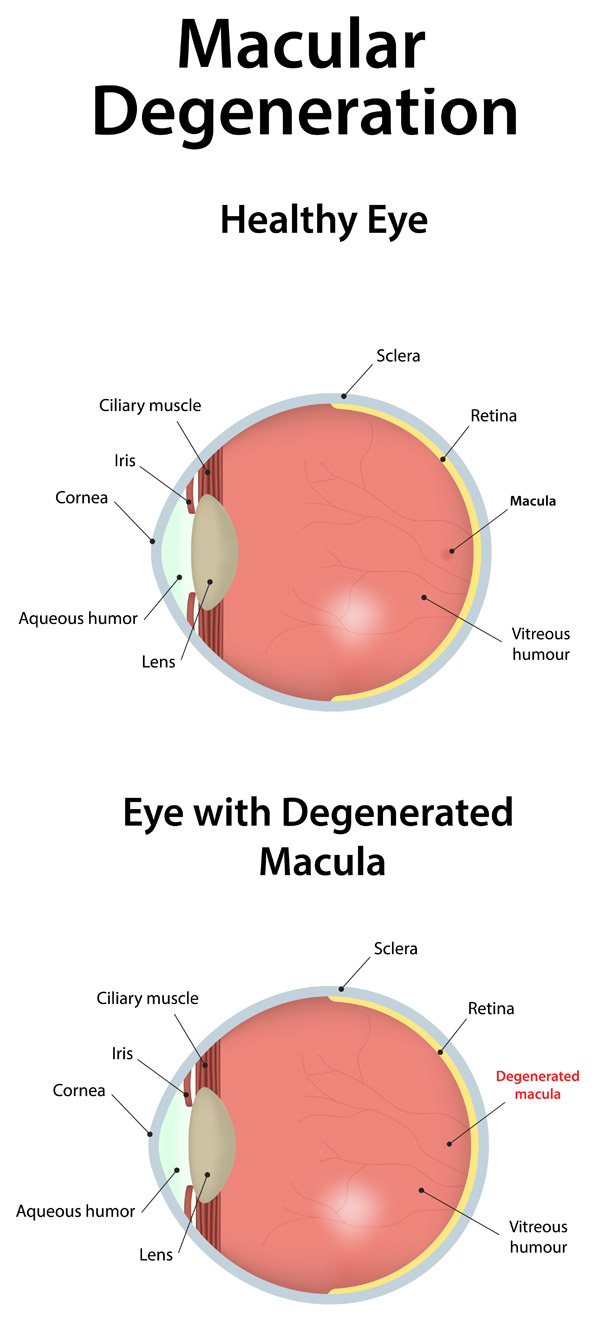Macular Degeneration: Treatments and Research
If You Have Advanced AMD
Once dry AMD reaches the advanced stage, no form of treatment can prevent vision loss. However, treatment can delay and possibly prevent intermediate AMD from progressing to the advanced stage.
The National Eye Institute's Age-Related Eye Disease Study found that taking certain vitamins and minerals may reduce the risk of developing advanced AMD.
Wet AMD can be treated with laser surgery, photodynamic therapy, and injections into the eye. None of these treatments is a cure for wet AMD. The disease and loss of vision may progress despite treatment.
Laser Surgery
Laser surgery uses a laser to destroy the fragile, leaky blood vessels. Only a small percentage of people with wet AMD can be treated with laser surgery. Laser surgery is performed in a doctor's office or eye clinic.
The risk of new blood vessels developing after laser treatment is high. Repeated treatments may be necessary. In some cases, vision loss may progress despite repeated treatments.
Photodynamic Therapy
With photodynamic therapy, a drug called verteporfin is injected into your arm. It travels throughout the body, including the new blood vessels in your eye. The drug tends to stick to the surface of new blood vessels.
Next, the doctor shines a light into your eye for about 90 seconds. The light activates the drug. The activated drug destroys the new blood vessels and leads to a slower rate of vision decline.
Unlike laser surgery, verteporfin does not destroy surrounding healthy tissue. Because the drug is activated by light, you must avoid exposing your skin or eyes to direct sunlight or bright indoor light for five days after treatment. Photodynamic therapy is relatively painless. It takes about 20 minutes and can be performed in a doctor's office.
Photodynamic therapy slows the rate of vision loss. It does not stop vision loss or restore vision in eyes already damaged by advanced AMD. Treatment results often are temporary. You may need to be treated again.
Drug Treatment for Wet AMD
Wet AMD can now be treated with new drugs that are injected into the eye (anti-VEGF therapy). Abnormally high levels of a specific growth factor occur in eyes with wet AMD and promote the growth of abnormal new blood vessels. This drug treatment blocks the effects of the growth factor.
You will need multiple injections that may be given as often as monthly. The eye is numbed before each injection. After the injection, you will remain in the doctor's office for a while and your eye will be monitored. This drug treatment can help slow down vision loss from AMD and in some cases improve sight.
If You Have Low Vision
If you have lost some sight from AMD, don't be afraid to use your eyes for reading, watching TV, and other routine activities. Normal use of your eyes will not damage your vision further. If you have lost some sight from AMD, ask your eye care professional about low vision services and devices that may help you make the most of your remaining vision.
Many community organizations and agencies offer information about low vision counseling and training and other special services for people with visual impairments.
Research on AMD
The National Eye Institute is conducting and supporting a number of studies to learn more about AMD.
For example, scientists are
- studying the possibility of transplanting healthy cells into a diseased retina
- evaluating families with a history of AMD to understand genetic and hereditary factors that may cause the disease
- looking at certain anti-inflammatory treatments for the wet form of AMD
This research should provide better ways to detect, treat, and prevent vision loss in people with AMD.

